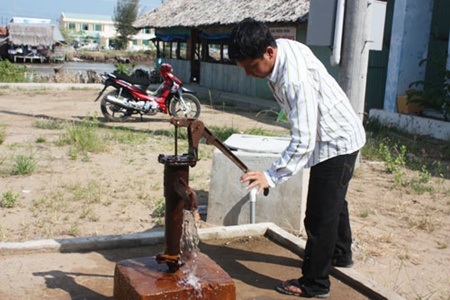

Thousands of residents of Kien Hai District were suffering from a severe shortage of water.
Luong Quoc Binh, chairman of the district's People's Committee, stated that Kien Hai District comprised 23 islands, but only three large islands of Hon Tre in Hon Tre commune, Hon Lon in An Son commune, Hon Son Rai in Lai Son commune and some small islands with a few people have sufficient water.
The remaining parts were suffering from a severe shortage of water, he noted.
Of those, many islands in An Son and Nam Du communes, which are located about 90 kilometres offshore from the centre Rach Gia City, were reported to be in a serious situation. It takes about three hours by high-speed boat and six hours by normal boat to reach the islands.
Every year, soon after the Lunar New Year (around February), the dry season in the district follows and stored rainwater becomes scarce, forcing local residents to buy water from other islands.
"Water to drink every day is now more expensive than my family's food," said Huynh Van Luan, a resident who has been living in Nam Du district commune's An Phu Village for nearly 20 years.
"In recent dry seasons, the weather has become hotter and muggier, and sometimes we have no rain for six to seven months, so the water sources on the island become scarce," he added.
Secretary of the commune's Party's Committee Huynh Van Loi stated that of the commune's total 834 households with more than 3,600 residents, only a few of the families could buy large jars or build tanks by themselves to store rainwater, mostly for cooking and drinking.
"They save water by washing and bathing in sea water and then rinsing with a small amount of drinking water," he noted.
Loi pointed out that some wells were available in the commune, but all have gone dry since the dry season started, so people had to travel by boat to Bai Men, which is located 8 kilometres away, to buy water.
The water price has now skyrocketed to VND160,000 per cubic metre, he said.
"Besides, not many people work in water transportation, as it is quite costly to buy equipment for the transportation," Loi explained, adding that residents had to build their own fishing and passenger boats to transport water from other villages.
Meanwhile, the only reservoir in An Son commune has been dry for a while.
Pham Van Quan, chairman of the commune's People's Committee, stated that though locals used water very economically, the water always ran dry right after the Lunar New Year, as the storage was just two-thirds of the reservoir's capacity.
As a result, for nearly three months now, most of the people in the commune have had to buy water from some lucky households who owned wells that still contained water.
"Of the many wells in the commune, there are only 10 still containing water, serving more than 4,500 residents of over 1,200 households," he pointed out.
Each 20-litre can of water was sold at VND4,000–6,000, he said.
Doan Hong Duy, deputy chairman of Kien Hai District's People's Committee, said that the district had planned various projects to improve the situation but none had been realised or showed feasibility.
He stated that the Kien Giang Province's Department of Agriculture and Rural Development had a plan to make special nylon bags that could be used to store water.
"The special bags, which will be distributed free of charge to the locals, will be more mobile and convenient than the large pottery jars used for storing water," he added.
However, Duy said he did not have full clarification for the use of the bags as everything was still in the discussion stage.





- 2024 International Youth Festival attracts 3,000 local and international youth
- Hanoi launches pilot project to integrate electronic health records into VNeID app
- Empowering new generation of biodiversity champions in Vietnam
- Capital Law to make Hanoi major center for quality education
- Hanoi raises road safety awareness among students
- Hanoi pilots artificial intelligence in five schools
